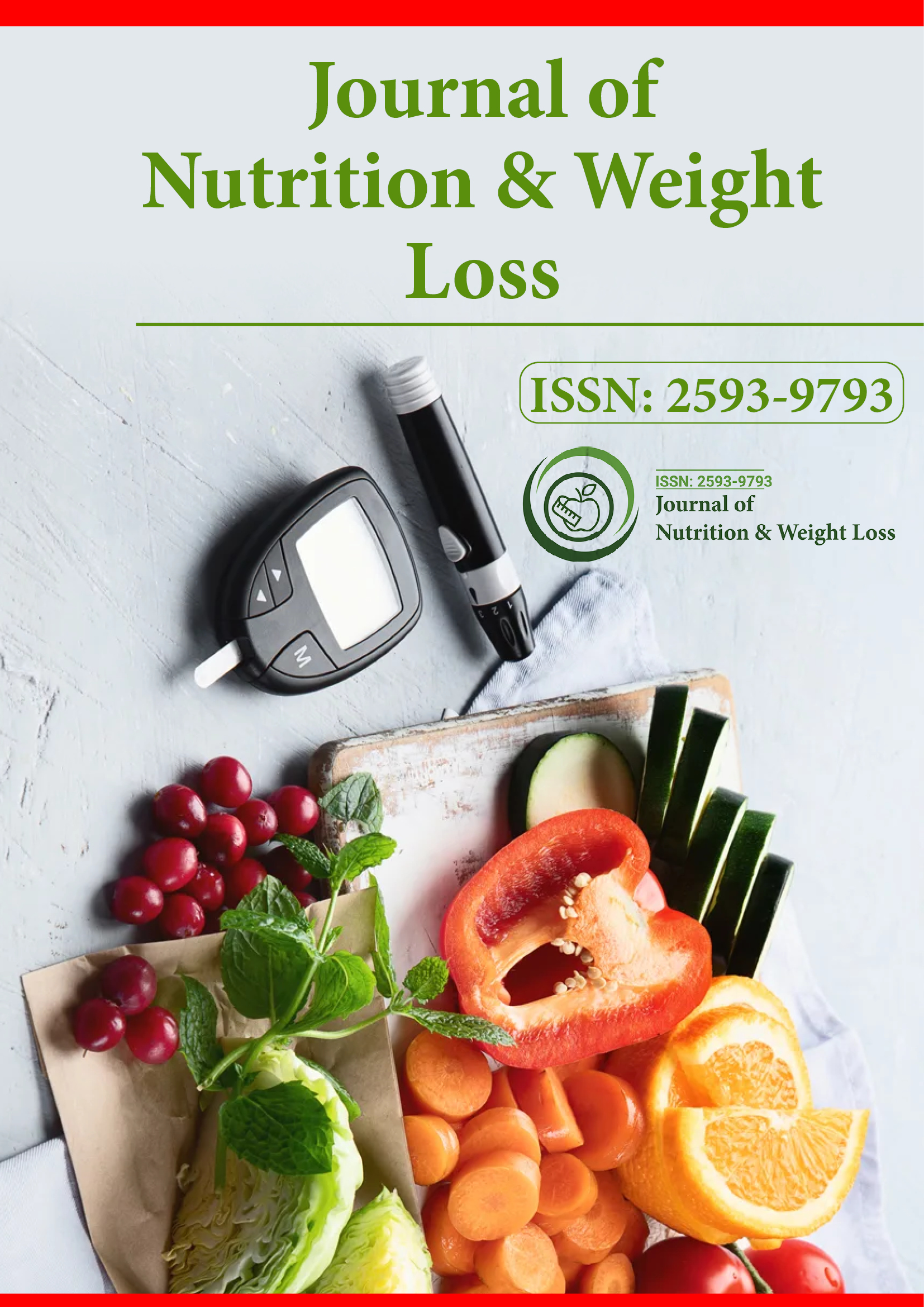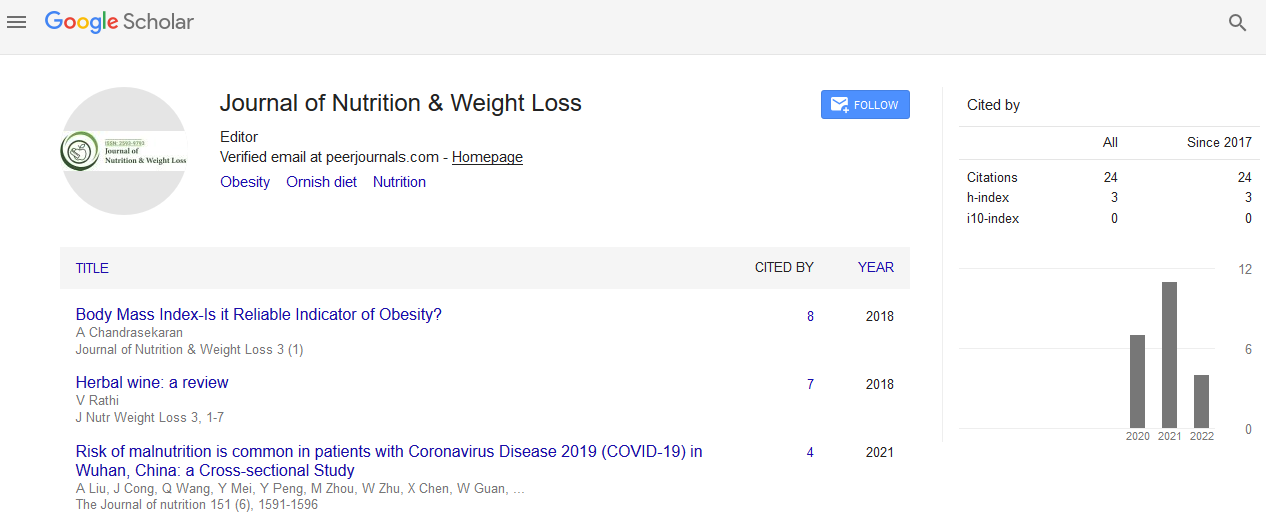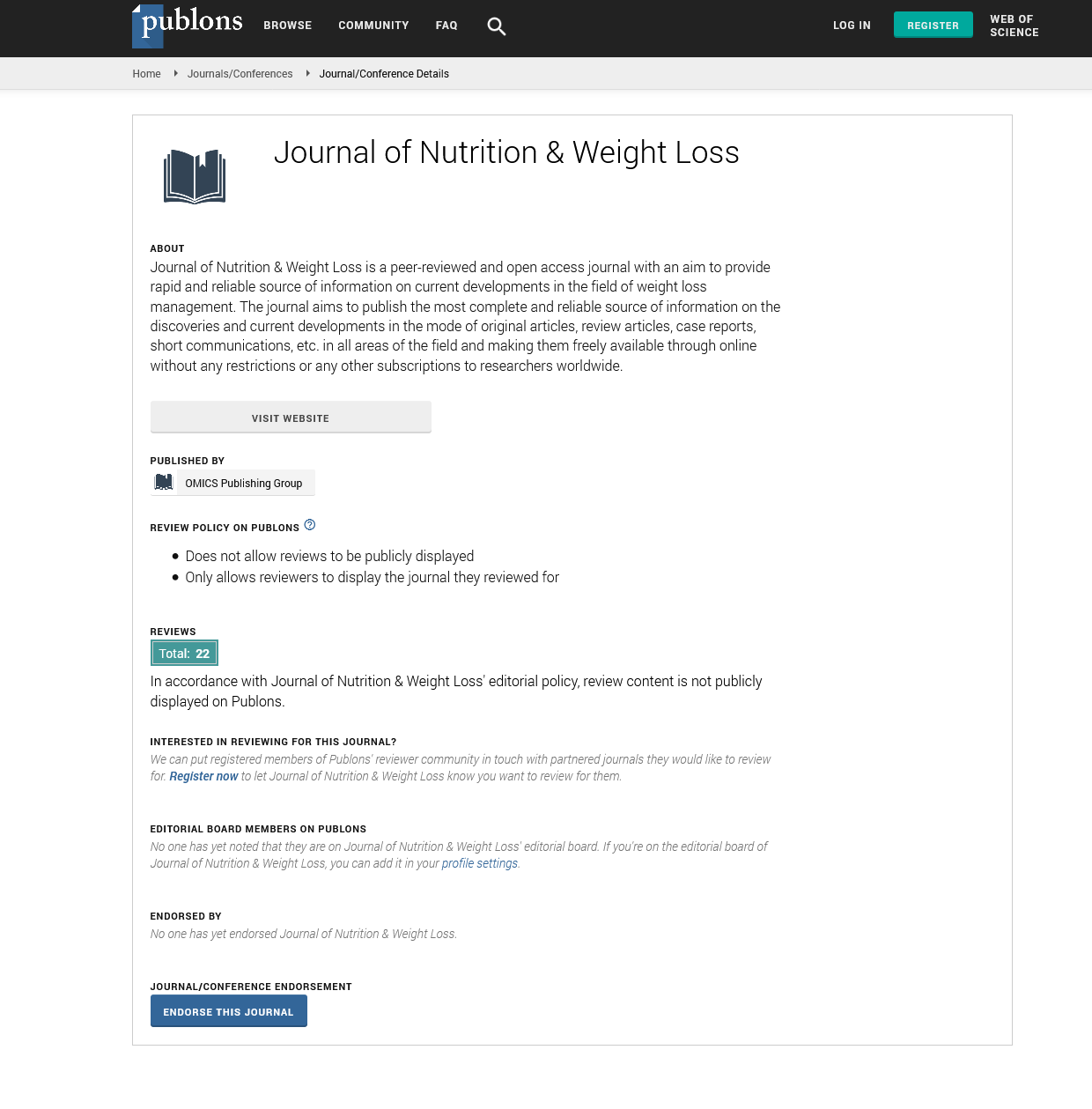Indexed In
- RefSeek
- Hamdard University
- EBSCO A-Z
- Publons
- Euro Pub
- Google Scholar
Useful Links
Share This Page
Journal Flyer

Open Access Journals
- Agri and Aquaculture
- Biochemistry
- Bioinformatics & Systems Biology
- Business & Management
- Chemistry
- Clinical Sciences
- Engineering
- Food & Nutrition
- General Science
- Genetics & Molecular Biology
- Immunology & Microbiology
- Medical Sciences
- Neuroscience & Psychology
- Nursing & Health Care
- Pharmaceutical Sciences
Commentary - (2022) Volume 7, Issue 2
Effect of Nutrition on Cardiovascular Disease
Ashley K Ormiston*Received: 08-Mar-2022, Manuscript No. JNWL-22-16242; Editor assigned: 11-Mar-2022, Pre QC No. JNWL-22-16242 (PQ); Reviewed: 25-Mar-2022, QC No. JNWL-22-16242; Revised: 01-Apr-2022, Manuscript No. JNWL-22-16242 (R); Published: 08-Apr-2022, DOI: 10.35248/2593-9793.22.7.131
Description
The main cardiovascular diseases affecting developed countries have at their core atherosclerosis and hypertension, both of which are profoundly influenced by diet and can be accessed, at least in part, from a nutritional point of view, like the growing obesity "pandemic". A diet is a multi-component mixture of many nutrients, which can interact with each other. Certainly, studying nutrients and their impact on cardiovascular disease can be daunting. Many dietary risk factors contribute to these diseases in different ethnic settings and settings. These risk factors are often evident in young people, so precautions must be taken early in life. Although most of the information about nutritional risk factors and cardiovascular disease derives from studies in the developed world, the situation is rapidly evolving toward epidemic proportions in the developing world where a major burden on the economy and health services will be imposed [1].
The main dietary determinants of hypercholesterolemia are fats, especially saturated fat, and dietary cholesterol. Unlike dietary fats, which are absorbed almost entirely in the intestinal tract, cholesterol absorption is incomplete and regulated at the level of the intestinal epithelium. Eating a lot of fat strongly influences the risk of developing cardiovascular disease (CVD). Saturated fatty acids commonly found in dairy products and meat raise cholesterol levels. In addition, studies have also shown that Trans fatty acids, found in industrial hard oils, increase the risk of coronary heart disease. Although they have been eliminated from infection in many parts of the world, Trans fatty acids are still present in fried fast foods and baked goods.
In many developing countries, oils high in saturated fat can be a staple of their diets, although it should be noted that in many of these countries, total daily fat intake is low. Significantly higher than average consumption in industrialized countries. Unsaturated fatty acids are divided into several different categories; Monounsaturated fatty acids are found mainly in olive oil, n6 polyunsaturated fatty acids, n3 polyunsaturated fatty acids, and trans fatty acids. Each is functionally different, associated with elevated blood cholesterol and cardiovascular disease [2,3].
Cholesterol in the body comes from two main sources: endogenous synthesis and absorption from food. Unlike triacylglycerol, which is the predominant form of fat, which is almost completely absorbed, partial absorption of cholesterol in the gut is only about 50%, although there is great variation in individual absorption rates. The amount of cholesterol in the intestinal lumen comes from 2 main sources; dietary cholesterol and cholesterol excreted by the liver in bile (range 800-1300 mg per day). The mechanism of absorption does not distinguish between these two sources of cholesterol. As with the role of dietary fats in regulating cholesterol levels, there is epidemiological, experimental, and clinical evidence for the importance of cholesterol intake in regulating cholesterol homeostasis in body and plasma [4]. The National Cholesterol Education Program guidelines recommend less than 300 mg of dietary cholesterol per day.
For many years, research on the link between diet and heart disease has focused on individual nutrients like cholesterol (and foods high in dietary cholesterol, like eggs), types of fat, and cholesterol specific vitamins and minerals. This work has been eye-opening, but it also creates dead ends, as well as myths and confusion about what constitutes a heart-healthy diet. That's because people eat food, not nutrients.
• The best diet to prevent heart disease is one rich in fruits and vegetables, whole grains, nuts, fish, poultry, and vegetable oils. Include alcohol in moderation, if any; and easily eat red and processed meat, refined carbohydrates, foods and drinks with added sugar, sodium, and foods with trans fats.
• People whose diets fit this diet had a 31% lower risk of heart disease, a 33% lower risk of diabetes, and a 20% lower risk of stroke.
• A randomized controlled trial showed that a Mediterranean diet supplemented with extra virgin olive oil or walnuts, two rich sources of unsaturated fats, reduced the rate of major cardiovascular events in patient’s cardiovascular disease during 4.8 years of follow-up.
• This study found that a low-fat diet is not beneficial for heart health, and that incorporating healthy fats - such as those found in the Mediterranean diet - can improve health cardiovascular and weight loss.
• There is no one exact Mediterranean diet, as this style of eating takes into account different foods, eating habits and lifestyles in several countries bordering the Mediterranean Sea. However, there are similarities that define the Mediterranean dietary pattern, including: high consumption of olive oil, nuts, vegetables, fruits and whole grains; eat fish and poultry in moderation; low consumption of dairy products, red meat, cold meat and sweets; and wine in moderation, taken with meals [5].
REFERENCES
- McGill HC, Geer JC, Strong JP (1963) Natural history of human atherosclerotic lesions. In: Sandler M, Bourne growthhormone (GH), eds. Atherosclerosis and Its Origin. New York: Academic Press.
- Amirbekian V, Lipinski MJ, Briley-Saebo KC, Amirbekian S, Aquinaldo JG, Weinreb DB, et al. Detecting and assessing macrophages in vivo to evaluate atherosclerosis noninvasively using molecular MRI. Proc Natl Acad Sci U S A. 2007;104:961-966.
[Crossref] [Google Scholar].
- McGill HC, McMahan CA, Malcom GT, Oalmann MC, Strong JP. Relationship of glycohemoglobin and adiposity to atherosclerosis in youth. Pathobiological Determinants of Atherosclerosis in Youth (PDAY) Research. Arterioscler Thromb Vasc Biol. 1995; 15(4):431-440.
- Lloyd-Jones DM, Hong Y, Labarthe D, et al. Defining and setting national goals for cardiovascular health promotion and disease reduction: the American Heart Association’s strategic Impact Goal through 2020 and beyond. Circulation. 2010;121:586-613.
- Maclure KM, Hayes KC, Colditz GA, Stampfer MJ, Speizer FE, Willett WC. Weight, diet, and the risk of symptomatic gallstones in middle-aged women. N Engl J Med. 1989;321(9):563-9.
Citation: Ormiston AK (2022) Effect of Nutrition on Cardiovascular Disease. J Nutr Weight Loss. 7:131.
Copyright: © 2022 Ormiston AK. This is an open access article distributed under the terms of the Creative Commons Attribution License, which permits unrestricted use, distribution, and reproduction in any medium, provided the original author and source are credited.


